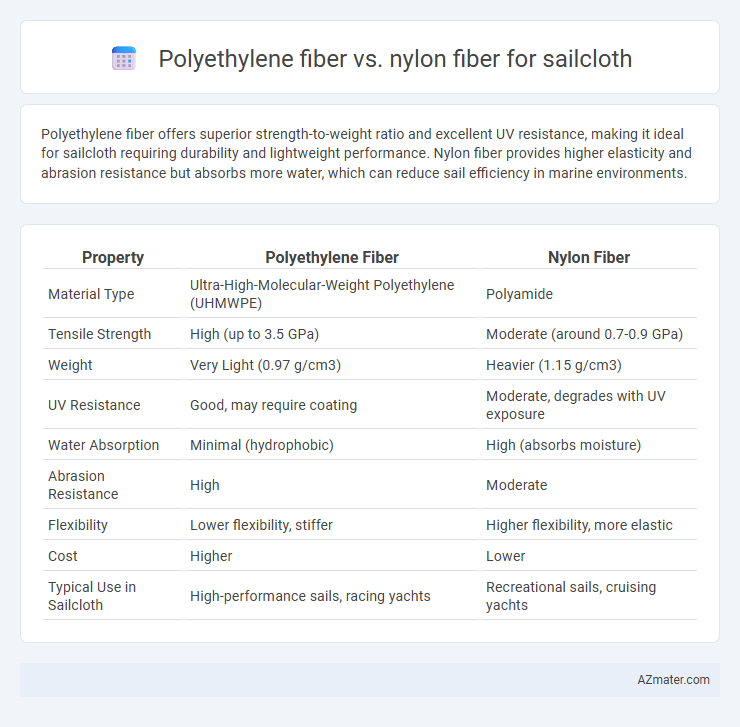Polyethylene fiber offers superior strength-to-weight ratio and excellent UV resistance, making it ideal for sailcloth requiring durability and lightweight performance. Nylon fiber provides higher elasticity and abrasion resistance but absorbs more water, which can reduce sail efficiency in marine environments.
Table of Comparison
| Property | Polyethylene Fiber | Nylon Fiber |
|---|---|---|
| Material Type | Ultra-High-Molecular-Weight Polyethylene (UHMWPE) | Polyamide |
| Tensile Strength | High (up to 3.5 GPa) | Moderate (around 0.7-0.9 GPa) |
| Weight | Very Light (0.97 g/cm3) | Heavier (1.15 g/cm3) |
| UV Resistance | Good, may require coating | Moderate, degrades with UV exposure |
| Water Absorption | Minimal (hydrophobic) | High (absorbs moisture) |
| Abrasion Resistance | High | Moderate |
| Flexibility | Lower flexibility, stiffer | Higher flexibility, more elastic |
| Cost | Higher | Lower |
| Typical Use in Sailcloth | High-performance sails, racing yachts | Recreational sails, cruising yachts |
Introduction to Sailcloth Materials
Polyethylene fiber, commonly known by the brand name Dyneema, offers exceptional strength-to-weight ratio and high resistance to UV rays and moisture, making it ideal for lightweight, durable sailcloth. Nylon fiber provides excellent elasticity and abrasion resistance, enhancing sail shape retention and flexibility in variable wind conditions. Choosing between polyethylene and nylon fibers depends on prioritizing either maximum strength and durability or flexibility and stretch performance in sailcloth applications.
Overview of Polyethylene Fiber
Polyethylene fiber, known for its exceptional strength-to-weight ratio, offers superior durability and resistance to UV radiation and moisture, making it ideal for sailcloth applications. Its low stretch properties provide excellent shape retention under high wind loads, enhancing sail performance and longevity compared to nylon fiber. The fiber's lightweight nature contributes to easier handling and improved overall sailing efficiency.
Overview of Nylon Fiber
Nylon fiber, known for its excellent tensile strength and abrasion resistance, is widely utilized in sailcloth manufacturing due to its durability and flexibility under varying wind conditions. Unlike polyethylene fiber, nylon offers superior elasticity, allowing sails to maintain shape and performance during dynamic loads and strong gusts. Its moisture resistance and ability to absorb dyes also provide enhanced longevity and colorfastness, making nylon a preferred choice for high-performance sailing applications.
Strength-to-Weight Comparison
Polyethylene fiber offers an exceptional strength-to-weight ratio, making it significantly lighter than nylon fiber while maintaining high tensile strength essential for sailcloth performance. Nylon fiber, although strong and flexible, tends to absorb moisture and weigh more, which can reduce overall sail efficiency and durability in marine environments. Polyethylene's low density and superior resistance to water absorption provide enhanced strength retention, crucial for maximizing sailcloth performance in demanding offshore conditions.
Durability and UV Resistance
Polyethylene fiber, such as Spectra or Dyneema, offers superior UV resistance and exceptional durability, maintaining strength and flexibility even after prolonged sun exposure, making it ideal for high-performance sailcloth. Nylon fiber, while strong and resilient, tends to degrade faster under UV radiation and requires additional coatings or treatments to enhance its longevity in marine environments. The inherent resistance of polyethylene to water absorption and UV damage results in longer-lasting, more reliable sailcloth compared to nylon-based alternatives.
Flexibility and Handling
Polyethylene fiber offers superior flexibility and low stretch, making it highly responsive and easier to handle when used in sailcloth. Nylon fiber, while strong and elastic, tends to absorb moisture and stretch more, which can reduce maneuverability and lead to shape distortion over time. Sailcloth made from polyethylene maintains consistent tension and shape under load, enhancing overall sail performance and durability.
Water Absorption and Weather Performance
Polyethylene fiber exhibits extremely low water absorption, which enhances its dimensional stability and maintains strength in wet conditions, making it ideal for sailcloth exposed to marine environments. Nylon fiber absorbs more water, resulting in increased weight and reduced tensile strength when wet, which can compromise sail performance and durability. Polyethylene's superior resistance to UV radiation and saltwater degradation ensures longer-lasting weather performance compared to nylon, which tends to deteriorate faster under prolonged exposure to sunlight and moisture.
Cost and Availability
Polyethylene fiber, commonly known as Dyneema or Spectra, offers high strength-to-weight ratio but typically comes at a higher cost compared to Nylon fiber. Nylon fiber is more widely available and less expensive, making it a cost-effective option for sailcloth production. The choice between these fibers depends on balancing budget constraints with performance requirements, as Nylon provides affordable durability while Polyethylene delivers superior tensile strength and UV resistance.
Environmental Impact
Polyethylene fiber, particularly high-modulus polyethylene (HMPE), offers low environmental impact due to its high strength-to-weight ratio, which reduces material usage and extends sailcloth lifespan, thereby minimizing waste. Nylon fiber production involves higher energy consumption and emits more greenhouse gases, contributing to a larger carbon footprint compared to polyethylene. Biodegradability is limited in both fibers, but polyethylene's recyclability and durability make it a more sustainable choice for eco-conscious sailcloth manufacturing.
Choosing the Right Fiber for Your Sailing Needs
Polyethylene fiber offers exceptional strength-to-weight ratio and excellent resistance to UV radiation and water absorption, making it ideal for lightweight, long-lasting sailcloth in high-performance sailing. Nylon fiber provides superior elasticity and abrasion resistance, which benefits durability and flexibility under dynamic wind conditions, especially in cruising sails. Choosing the right fiber depends on your sailing priorities: opt for polyethylene if you need low stretch and maximum strength, while nylon suits applications requiring resilience and enhanced wear resistance.

Infographic: Polyethylene fiber vs Nylon fiber for Sailcloth
 azmater.com
azmater.com